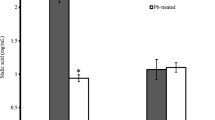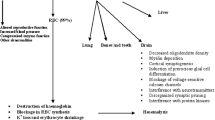Abstract
More than 95% of lead, a environmental heavy metal, entering into blood accumulates in erythrocytes suggesting erythrocytes as an important target of lead toxicity. Recent studies reported that erythrocytes could contribute to blood coagulation via phosphatidylserine (PS) exposure in erythrocytes. However,in vivo effects of chronic lead exposure especially by drinking water on procoagulant activity of erythrocytes have not been studied yet. In the present study, we investigated the effects of chronic exposure of lead by drinking water on erythrocytes in rats. Groups of 40 male rats were provided with drinking water containing various concentrations of lead for 4 weeks and complete blood cell count, procoagulant activities of erythrocytes and platelets were evaluated with basic inspections on body weight and food/water consumption. The administration of lead containing drinking water increased the blood lead level (BLL) in a dose-dependent manner up to 22.39±2.26 μg/dL. Water consumption was significantly decreased while food consumption or body weight gain was not affected. In contrast to the previous findings with acute lead exposure, chronic lead exposure failed to increase PS exposure in erythrocytes with statistical significance although some trends of enhancement were observed. It implies that a certain adaptation might have happened in body during repeated exposure to lead, resulting in attenuation of PS exposure. With this study, we believe that a valuable information was provided for the study on the toxicological significance and the risk assessment of lead contaminated drinking water.
Similar content being viewed by others
References
Battistini, V., Morrow, J. J., Ginsburg, D., Thompson, G., Moore, M. R., and Goldberg, A., Erythrocyte delta-aminolaevulic acid dehydrase activity in anaemia.Br. J. Haematol., 20, 177–184 (1971).
CDCP. Screening Young Children for Lead Poisoning: Guidance for State and Local Public Health Officials. Atlanta: USA Department of Health and Human Services, Public Health Service. (1997).
Fukumoto, K., Karai, I., and Horiguchi, S., Effect of lead on erythrocyte membranes.Br. J. Ind. Med., 40, 220–223 (1983).
Goyer, R. A. and Clarkson, T. W., Toxic effects of metals. InCasarett and Doull's Toxicology: The Basic Science of Poisons. (Klaassen, C. D., Ed). pp 829, McGraw-Hill, New York. (2001).
Goyer, R. A., Lead toxicity: current concerns.Environ. Health. Perspect. 100, 177–187 (1993).
Lustberg, M. and Silbergeld, E., Blood lead levels and mortality.Arch. Intem. Med., 162, 2443–2449 (2002).
McEvoy, L., Williamson, P., and Schlegel, R. A., Membrane phospholipid asymmerty as a determinant of erythrocyte recognition by macrophages.Proc. Natl. Acad. Sci. U.S.A., 83, 3311–3315 (1986).
Monteiro, H. P., Abdalla, D. S., Augusto, O., and Bechara, E. J., Free radical generation during delta-aminolevulinic acid autoxidation: induction by hemoglobin and connections with porphyrinpathies.Arch. Biochem. Biophys., 271, 206–216 (1989).
Navas-Acien, A., Selvin, E., Sharrett, A. R., Calderon-Aranda, E., Silbergeld, E., and Guallar, E., Lead, cadmium, smoking, and increased risk of peripheral arterial disease.Circulation, 109, 3196–3201 (2004).
Shin, J. H., Lim, K. M., Noh, J. Y., Bae, O. N., Chung, S. M., Lee, M. Y., and Chung, J. H., Lead-induced procoagulant activation of erythrocytes through phosphatidylserine exposure may lead to thrombotic diseases.Chem. Res. Toxicol, in press (2006).
Torrente, M., Colomina, M. T., and Domingo, J. L., Behavioral effects of adult rats concurrently exposed to high doses of oral manganese and restraint stress.Toxicology., 211, 59–69 (2005).
Waldron, H. A., The anaemia of lead poisoning: a review.Br. J. Ind. Med., 23, 83–100 (1966).
Zwaal, R. F. and Schroit, A. J., Pathophysiologic implications of membrane phospholipid asymmetry in blood cells.Blood, 89, 1121–1132 (1997).
Zwaal, R. F., Comfurius, P., and Bevers, E. M., Surface exposure of phosphatidylserine in pathological cells.Cell Mol. Life Sci., 62, 971–988 (2005)
Author information
Authors and Affiliations
Corresponding author
Rights and permissions
About this article
Cite this article
Lee, MY., Shin, JH., Han, HS. et al. In vivo effects of lead on erythrocytes following chronic exposure through drinking water. Arch Pharm Res 29, 1158–1163 (2006). https://doi.org/10.1007/BF02969308
Received:
Issue Date:
DOI: https://doi.org/10.1007/BF02969308




